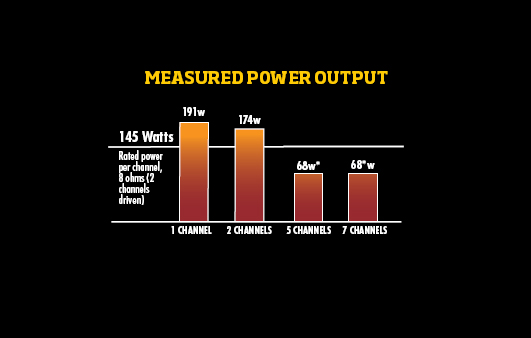Onkyo TX-NR5007 A/V Receiver Page 3

TEST BENCH
DOLBY DIGITAL PERFORMANCE
All data were obtained from various test DVDs using 16-bit dithered test signals, which set limits on measured distortion and noise performance. Reference input level is –20 dBFS, and reference output is 1 watt into 8 ohms. Volume setting for reference level was -5. All level trims at zero, except for subwoofer-related tests. All speakers were set to “large,” with subwoofer on. All are worst-case figures where applicable.
Output at clipping (1 kHz into 8/4 ohms)
1 channel driven: 191/171* W (22.8/22.3 dBW)
5 channels driven (8 ohms):
7 channels driven (8 ohms): 68 W** (18.3 dBW)
*Software impedance switch at “6 ohm” position; at the “4 ohm” position, power into 4 ohms was limited to approximately 68 W.
Distortion at 1 watt (THD+N, 1 kHz)
8/4 ohms: 0.02/0.03%
Noise level (A-wtd): –76.0 dB
Excess noise (with sine tone)
16-bit (EN16): 0.4 dB
Frequency response: 20 Hz to 20 kHz +0, –0.2 dB
MULTICHANNEL PERFORMANCE, ANALOG INPUT
Reference input and output level is 200 mV; volume setting for reference output level was -4.
Distortion (THD+N, 1 kHz, 8 ohms): 0.02%
Noise level (A-wtd): –90.4
Frequency response: <10 Hz to >200 kHz +0, –2.4 dB
STEREO PERFORMANCE, DIGITAL INPUT
Reference level is –20 dBFS; all level trims at zero. Volume setting for reference level was -3.5.
Output at clipping (1 kHz, 8/4 ohms, both channels driven): 174/148*** W (22.4 /21.7 dBW)
***Power into 4-ohm loads was limited by onboard protection circuits to approximately 150 watts with software impedance switch at “6 ohm,” and to about 65 W with the switch at “4 ohm.”
Distortion at reference level: 0.02%
Linearity error (at –90 dBFS): 0.1 dB
Noise level (A-wtd): –75.5 dB
with signals: –88.1 dB
Excess noise (with/without sine tone)
16-bit (EN16): 0.1/0.2 dB
quasi-20-bit (EN20): 9.2/7.0 dB
Noise modulation: 0.1 dB
Frequency response: <10 Hz to 20 kHz +0, –0.2 dB
with 96-kHz/24-bit signals: <10 Hz to 44.4 kHz +0, -0.9 dB
BASS-MANAGEMENT PERFORMANCE
Measured results obtained with Dolby Digital test signals.
Subwoofer-output frequency response (crossover set to 80 Hz): 24 dB/octave above –6-dB rolloff point of 80 Hz
High-pass-filter frequency response (crossover set to 80 Hz): 12 dB/octave below –3-dB rolloff point of 80 Hz
Maximum unclipped subwoofer output (trim at 0): 8.2v
Subwoofer distortion (from 6-channel, 30-Hz, 0-dBFS signal; subwoofer trim set to 0): 0.03%
Crossover consistency: bass crossover frequency and slope were consistent for all sources and formats.
Speaker size selection: all channels can be set to “small”
Speaker-distance compensation: available for all main channels.
Onkyo’s big TX-NR5007 predictably aced all of our qualitative tests, scoring noise and distortion numbers that bettered or equaled best-ever figures across the board. For example, PCM signal-to-noise was within a scant 0.2 dB of theoretical perfection on this real-world performance test. The Onkyo handily exceeded its single-channel and stereo power specs into 8-ohm loads, while power into 4 ohms was quite clearly (and deliberately) limited to about 50 % when more than 2 channels were driven toward the clipping point for more than a second or two. Whether this is meaningful in the real world is largely a philosophical question (and then only for those using lower-impedance loudspeakers), since music and movies rarely call for anything approaching full-scale output on more than one channel at a time, and then usually for only a small portion of a second at a time. —Daniel Kumin













































